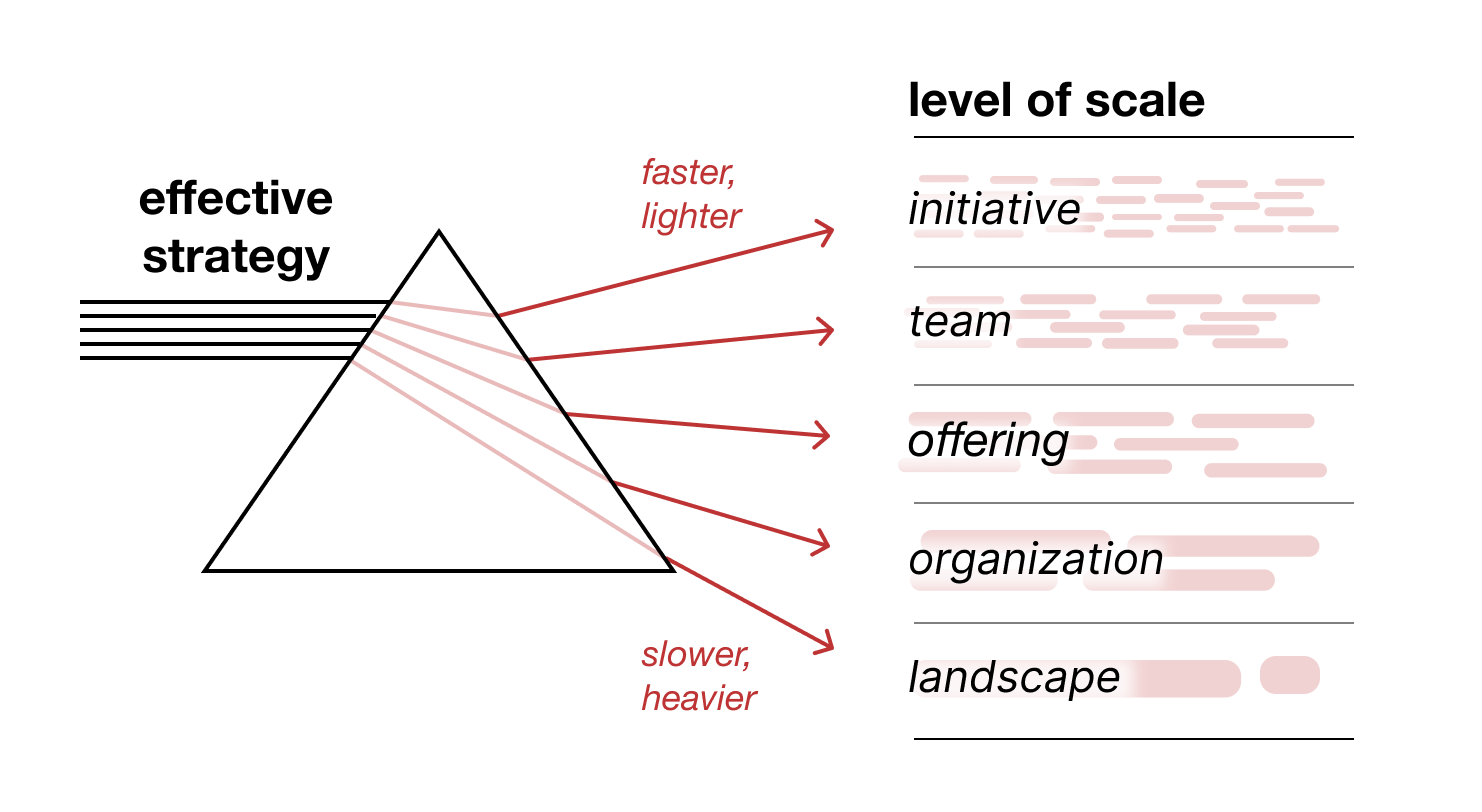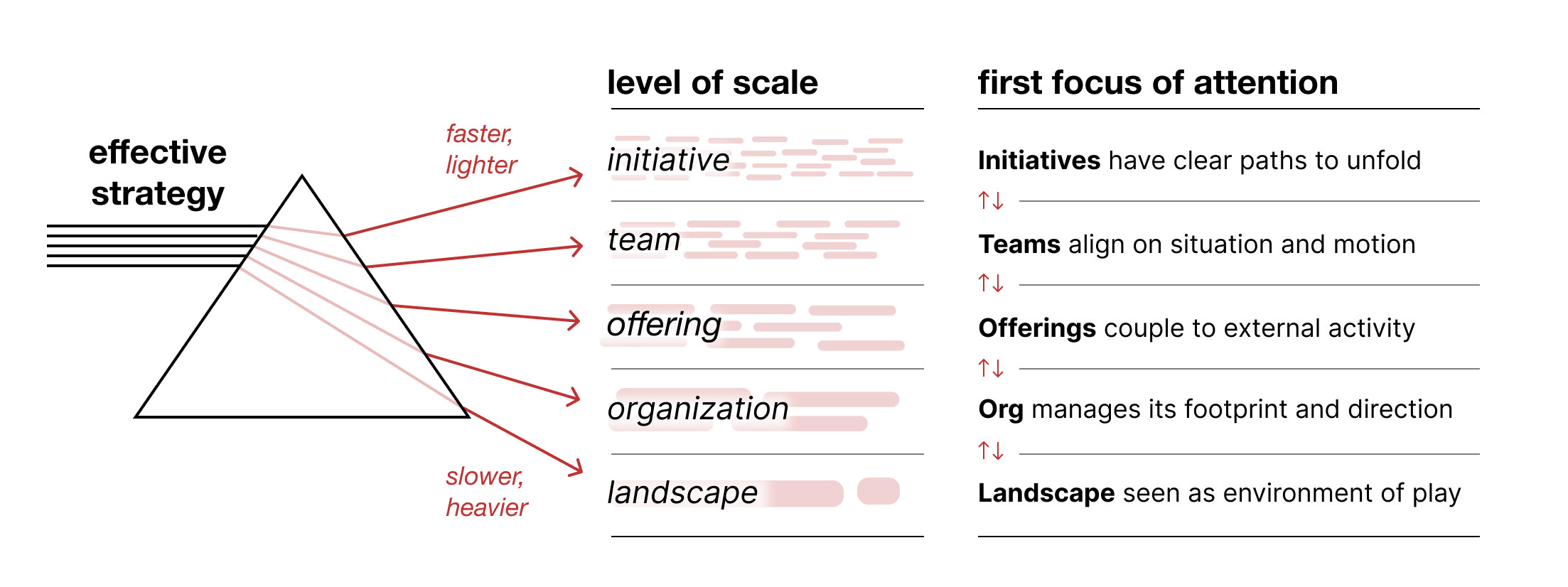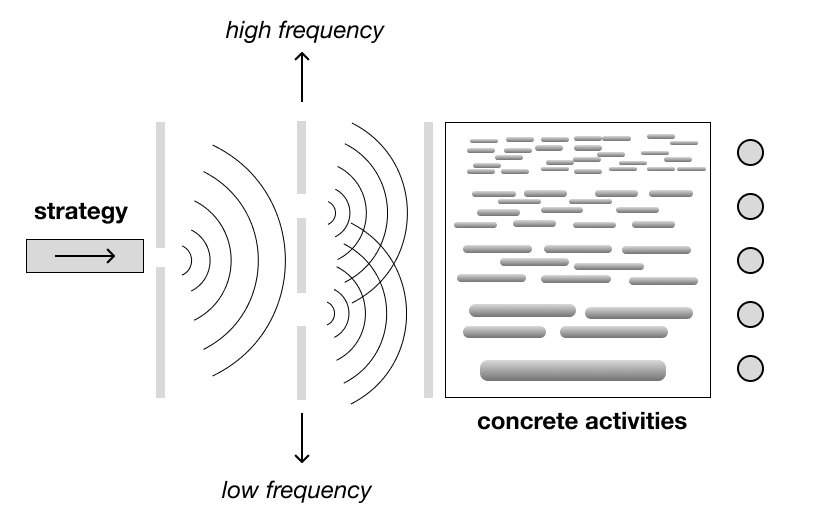We explored levels of scale a year ago as "Three Levels of Scale [LC04]." Back then, we looked at landscape (large), initiative (medium), and execution (small) as three core levels. I tried to show "strategy vs. execution" as a false dichotomy... but in that model, "execution" was its own, separate level. It preserved the divide I tried to deny by implicitly seating strategy in the two non-execution layers.
Strategic concern lives at every level of scale. With a guiding metaphor — splitting the light of strategy through a prism of speed and momentum — we can see five levels of scale, each with different means and modes of work.

Wherever we apply our effort (wherever we execute), we can locate those activities at a strategic level of scale. There are different kinds of strategic concerns at each level:
- Initiative: operating the spikes and packages and patterns of effort
- Team: understanding the situation and aligning the motion between people
- Offering: structuring products and services to match external reality
- Organization: mapping the operating footprint and managing its direction
- Landscape: anticipating and acting on external context and change
Effective strategy exists when good work exists at each level, and we reach a rough coherence between them.
Concrete activities over abstract principles
Traditional approaches to strategy treat it in the abstract: a set of different forces, a 3-part kernel, a series of choices. When I found the work of Porter and Rumelt* and Martin, I felt strong agreement in principle and limited potential for action: it made sense, but there was not a lot to get a handle on.
What we tend to see as "strategy" is limited to the organizational scale. It's expressed as a plan or a document, limited in scope to internal metrics or places of product focus. It rarely responds to the larger landscape context or acknowledges that internal capabilities, teams, and initiatives are the actual material the plan purports to guide and shape.

Effective strategy is inseparable from quality work at each level of scale. And it's concrete. It lives in how we shape our work, the models we make, interactions between individuals, the infrastructures we support, patterns of communication, descriptions of goals and targets, among many more visible structures and activities.
At each level of scale there are specific places we can focus our attention. There are concrete kinds of activites that need to operate well. And we, as individuals, can only see and influence a limited scope.
Strategy as maintenance and regeneration
Levels of scale help us characterize a larger structure we are trying to maintain and grow. In our current case, imagine an organization inside an ecosystem, composed of offerings, teams, and initiatives. Whether or not we intervene, most activities at most levels will continue on their current trajectory.
The reality of our strategy is the set of adjustments we make to that structure and its activities. In how we decide and act on those adjustments, and what we can learn from them as they continue on and on, at each level of scale. Effective strategy is continually choosing the right pieces at the right level of scale to repair, to adapt, or to build out latent strength — over and over and over again.
Other Things of Note
- *In January 2017, I flew to Stockholm to help edit an iteration of Majid Iqbal's book Thinking in Services. We worked in the office of an independent management consultant named David Nyman who introduced me to Porter and Rumelt, beginning my quest to get a handle on strategy. ("Dave Hora, Research Manager, PlanGrid" also contributed an essay to Thinking in Services: see page 62.)
- Last Friday, I was awarded an April 2025 "Employee of the Month" certificate by Dave's Research Company: more on LinkedIn. I can't wait to see who wins in May.
- Last week [LC20] I used the metaphor of wave-particle entanglement to bridge the quant/qual divide. Earlier, I tried that metaphor for today's strategic levels of scale. It was only after writing "high frequency" and "low frequency" on the double-slit mask (see below) I realized that didn't make sense: our main concern is speed and momentum, not observed position. The prism — splitting input according to frequency — feels like a much better fit.

Until next time—
This is Loops and Cycles, a mailing list exploring how we work together and make good things.


![Strategic Levels of Scale [LC21]](/content/images/size/w100/2025/05/strategy-prism-4.png)
